In England, steam locomotives were normally identified by counting wheels using Whyte's Notation. For instance '4-6-2' means four leading carrying wheels, six coupled wheels providing traction and two trailing carrying wheels. The English were never seduced by the equally reasonable idea of counting axles until the widespread adoption of diesel and electric traction, although Bullied called his 'Merchant Navy' Pacifics the '2 1 C' class.
If no qualifying letter was appended, it was assumed that there was a tender to carry the required water and fuel so, for instance, '0-6-0' implied a six-coupled locomotive with a tender.
It was convenient to produce designs omitting a tender for shunting or shorter distance working but this meant that the water tank had to be carried on the engine frames, together with the necessary fuel. The suffix 'T' is used to indicate 'Tank' and we call such engines 'Tank Engines'. In Germany, the term 'Tenderlok' is used for designs without a tender.
Early tank engines often carried water in a tank squeezed between the frames, underneath the boiler, rather limiting water capacity but early designers were very wary of raising the centre of gravity. I've driven an 1874 industrial six-coupled locomotive like this called 'Bellerophon' (not to be confused with the L.M.S, 'Jubilee' 4-6-0 of the 1930s). By providing outside cylinders and outside Gooch motion, a reasonable size water tank was included. A 'W' is often added to the designation to indicate 'Well Tank' so 'Bellerophon' is an 0-6-0WT.
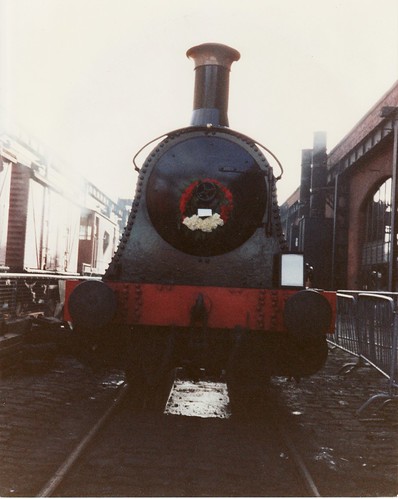
Visiting locomotive 'Bellerophon' at Manchester Museum of Science and Industry, carrying smokebox wreath and explanatory notice on the bufferbeam, commemorating the death of Mick Todd who was closely associated with the restoration of the locomotive.
Beattie designed a 2-4-0WT. I've driven both survivors. He somehow crammed inside motion (Stephenson Link, if I remember correctly) in front of the water tank, severely restricting capacity, so the lower part of the coal bunker is an extra water tank. I've written a post about these delightful engines here.
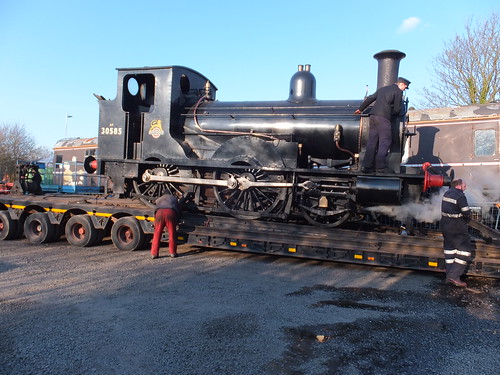 30585, still in steam, is chained in position on the low loader.
30585, still in steam, is chained in position on the low loader.
The 'saddle tank' was widely used, the name suggested by the curved shape of the tank placed on top of the boiler barrel, used particularly in small four-coupled engines like 'Henry' described here. An 'S' is often added to the designation. Saddle tanks are also used on larger 6-coupled locomotives like 0-6-0ST 'Sapper', described here. At least there's some space between the foot-framing (running plate) and the bottom of the tank to perform oiling and inspection. The disadvantage is that the water tank construction is complicated by the need to allow the chimney, dome and safety valves to pierce the tank, unless the tank is shortened to avoid either the chimney or safety valves.
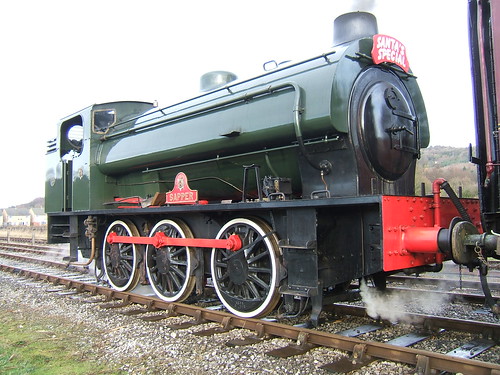 0-6-0ST 'Sapper'.
0-6-0ST 'Sapper'.
Carrying water in two flat tanks either side of the boiler then became a common practice. No extra letter was allocated so, for instance, 'Thomas the Tank' remains simply an 0-6-0T. I've driven a number of side tank locomotives (including a few posing as 'Thomas'). When you prepare a side tank with inside motion (which most British engines had), you quickly find the big disadvantage - access to the motion becomes very difficult, encouraging not-very-ladylike language.
 47298, posing as 'Thomas' shows her classic Midland lines and an odd paint job.
47298, posing as 'Thomas' shows her classic Midland lines and an odd paint job.
My posts on various 'Thomas' locomotives, all side tanks, are here.
The Great Western Railway used side tanks on its larger tank engines - this arrangement probably allows the largest water capacity.
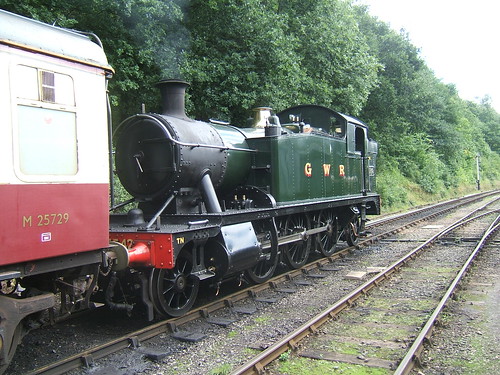 'Light Prairie' 5542 ready to depart from Shackerstone on the Battlefield Line.
'Light Prairie' 5542 ready to depart from Shackerstone on the Battlefield Line.
I'm afraid Britain was very slow to adopt a layout with two outside cylinders and outside Walschaerts motion, which eliminates the problem of access to the motion and allows full-length side tanks, although I've driven at least one such 0-4-0T - 'Cadbury No. 1' built by Avonside which worked at the Bournville chocolate factory.
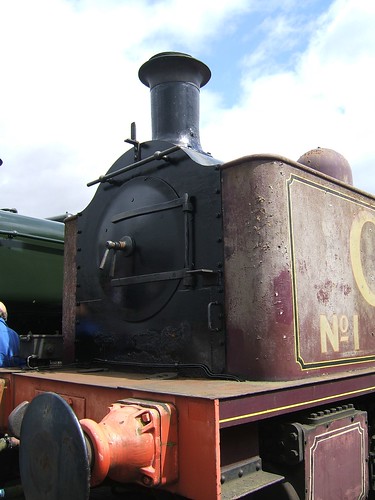
'Cadbury No. 1' has outside cylinders and Walschaerts motion, allowing full-length side tanks. The engine is currently out of traffic.
For their smaller tank engines, the Great Western Railway came up with a tank layout which allowed improved access to inside Stephenson Link Motion. Their solution has much to commend it - they used two 'pannier' water tanks allowing access to inside motion but leaving the top of the boiler unencumbered. A letter 'P' is often added to the designation. I've driven six or seven different 'Pannier' 0-6-0PT but not written a lot about these engines. These are capable, versatile engines and, as my friend John likes to remind me (after I used the phrase on a railway video) "You can do anything with a Pannier". There are some pictures of one example (5786) here. There are pictures of a later version (9466) which, remarkably was not built until 1952, here. I think Belgium was one of the few other countries which used the 'pannier' principle.
 Pannier tank 5786 'on shed' at Shackerstone.
Pannier tank 5786 'on shed' at Shackerstone.
Perversely, when the Great Western Railway did use Walschaerts motion (on the 4-cylinder express engines) they put it between the frames making access even worse than with link motion - just try oiling a 'Castle' or a 'King'. But valve motions are another story.
The Post Title
"Water, water, every where" is a line from The Rime of the Ancient Mariner by Samuel Taylor Coleridge.
